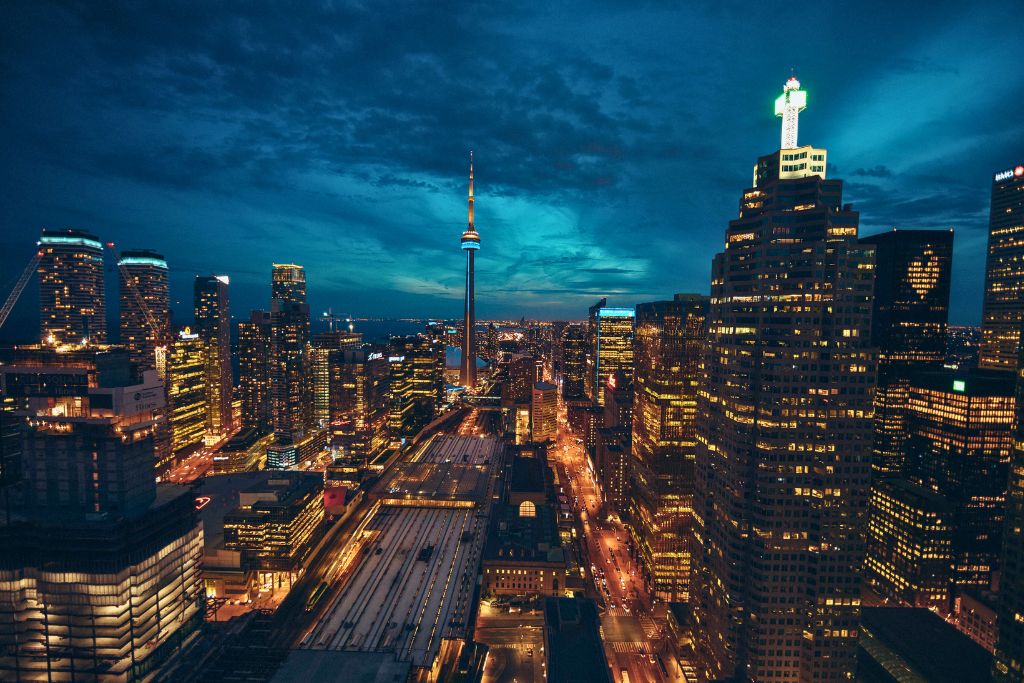Is Toronto Safe? What You Need to Know (From a Local)
Wondering if Toronto is safe? Here’s what you need to know in 2025
Toronto is one of the safest cities in North America. But like any major city, it’s not without its issues. As Canada’s largest city, welcoming over 27 million visitors annually, it’s worth considering safety before your trip.
While crime rates in Toronto have risen over the past few years, this shouldn’t deter you from visiting. The reality is, your risk of being affected by serious crime is very low—especially as a tourist.
As someone who’s lived in Toronto since 2018, I can give you an honest overview on safety in the city. Personally, I’ve always felt safe in Toronto, both as a long-term resident and during my early days as a visitor.
Sure, Toronto has the hustle and bustle you’d expect from a big city, but it’s also incredibly welcoming and, for the most part, safe. I’ve walked home late at night in many neighbourhoods and never felt uneasy. That said, like any major city, Toronto has its quirks—and yes, a few areas you might want to avoid.
Living in the heart of downtown, near many of the city’s key attractions, I know exactly what visitors should be aware of—whether you’re planning a short trip or considering a move here.
To help you prepare for your trip, I’ve put together this complete guide to safety in Toronto, including my perspective as a local, as well as practical tips to help you navigate the city with confidence. So, read on for everything you need to know about safety in Toronto!
Chasing Chanelle contains affiliate links and is a member of the Amazon Services LLC Associates Program. If you make a purchase using one of these links, we may receive compensation at no extra cost to you. We only recommend products and services we use and trust. Read our disclaimer for more information.
Is Toronto Safe?
The short answer is yes, Toronto is safe. In fact, in 2021 it was ranked as the 2nd safest major city in the world by the Economist’s Safe Cities Index. In 2024, CTV News ranked Toronto as the safest city in Canada, and according to Berkshire Hathaway Travel Protection, Toronto is one of the safest cities to travel to in 2025.
Compared to other major North American cities like New York, Chicago and Los Angeles, Toronto consistently ranks higher in terms of safety, with lower rates of violent crime and a strong sense of community.
And it’s not just the city of Toronto which is considered safe—Canada as a whole is one of the safest countries in the world, ranking 11th on the 2024 Global Peace Index.
That said, Toronto is still a big city, and like any major urban centre, it comes with its share of risks.
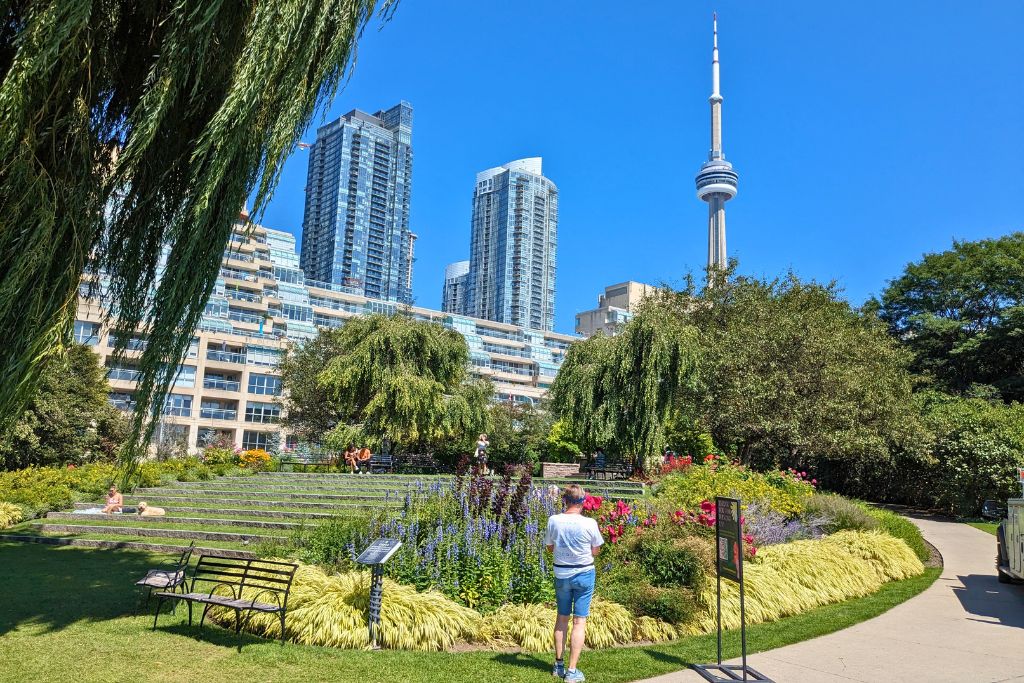
With a multicultural population of over 6 million people in the Greater Toronto Area (GTA) and more than 27 million visitors annually, Toronto is a bustling, cosmopolitan hub. From iconic Canadian landmarks and diverse neighbourhoods to a vibrant entertainment scene, there’s no shortage of things to see and do. But these attractions also present opportunities for petty crimes.
In recent years, the city has faced rising crime rates, particularly in violent crimes like shootings and homicides. While these incidents are often targeted and rarely affect tourists, they’re worth noting.
Additionally, Toronto has been struggling with a growing homelessness problem, which is more visible in certain areas of the city. While seeing this can be confronting, I’ve always proceeded with a bit more caution when passing through these areas, and have never felt unsafe. Although you’re probably unlikely to travel to these areas, it’s good to be aware of the situation.
Is Toronto Safe for Visitors?
For visitors, the most relevant concerns are petty crimes like theft, pickpocketing, and scams, which are more common in busy tourist areas and on public transit. However, encountering crime in downtown Toronto—where most key attractions are located—is actually pretty rare. With a little awareness and common sense, these risks are easy to manage.
Aside from crime, some other safety risks to be aware of in Toronto include road safety, weather conditions, food safety, and wildlife around the city.
So, is Toronto safe? Absolutely—especially if you stick to well-lit, busy areas, avoid a few higher-risk neighbourhoods, and take basic precautions. In the sections below, we’ll dive into everything you need to know to stay safe in Toronto, from common crimes and neighbourhood insights to environmental concerns and practical tips for navigating the city.
Crime in Toronto
When it comes to crime, Toronto is consistently ranked as one of the safest cities in Canada. However, like many major cities, it has seen rising crime rates in recent years. Despite this, Toronto remains a safe destination for travellers and is often considered one of the safest cities to visit in North America.
According to Statistics Canada’s Crime Severity Index (CSI), Toronto’s overall crime rate remains one of the lowest in the country.
While crime decreased overall during the COVID-19 pandemic due to lockdowns and reduced public activity, major crimes like assaults and auto thefts began rising again in 2022 and 2023. Unfortunately, 2024 has seen a continuation of this trend, with certain types of crime increasing further.
According to the Toronto Police Service, auto thefts surged by over 25% in 2024 compared to 2023, making it one of the fastest-growing crime categories. Violent crimes, including assaults and homicides have also seen a slight uptick compared to previous years.
However, for visitors, the likelihood of encountering serious crime remains very low, as these incidents are often targeted and rarely involve tourists. Instead, petty crimes and scams are more common and worth being aware of.
That said, as with any big city, it’s important to exercise common sense and take basic precautions, such as avoiding poorly lit areas at night and keeping an eye on your belongings in crowded places.
Personally, I’ve never witnessed any serious crimes in Toronto. The worst I’ve experienced are a few unpleasant encounters with unsavoury individuals on the street. And while my partner did have his bike stolen a couple of years ago, we were lucky enough to get it back!
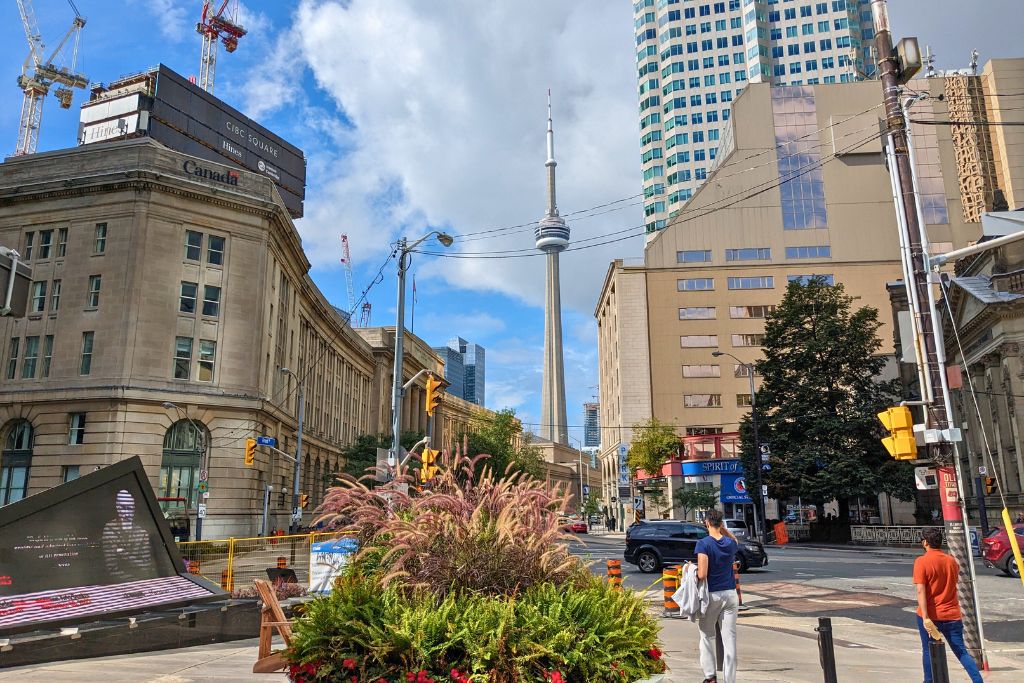
Major Crimes
While Toronto’s overall crime rate is low compared to other major cities, certain major crimes have seen increases in recent years. According to the Toronto Police Service, the most common major crimes include:
Assault
Assault is the most common type of crime in Toronto because it includes such a wide range of incidents. Under Canadian law, assault is broadly defined and can range from threats or attempts to physically harm someone to actual physical violence.
Both physical and sexual assaults have risen in recent years, particularly in densely populated areas. However, they mostly occur between people who already know each other, and random attacks on strangers are rare. So, this probably isn’t something you need to be too worried about. Still, I recommend staying aware of your surroundings, especially in crowded or unfamiliar areas.
Auto Theft
Car thefts have surged in recent years, with organized crime groups targeting high-end vehicles. In 2023, Toronto saw a 300% increase in auto thefts compared to a decade ago.
The most commonly stolen vehicles include luxury SUVs, which are often shipped overseas or sold on the black market. In 2024, the most stolen car in Ontario was the 2022 Lexus RX Series, followed closely by the 2022 Toyota Highlander.
If you’re visiting Toronto by car or renting a car here, always park in secure areas and consider using anti-theft devices or tracking systems to reduce the risk of theft.
Break-and-Enters
Residential and commercial break-ins have also increased, though these crimes rarely affect visitors. Most break-ins occur in residential neighborhoods and are often crimes of opportunity, such as targeting homes with unlocked doors or visible valuables.
Homicide
It’s worth noting that homicides, while often highlighted in the media, remain relatively rare in Toronto. Although they have increased slightly in 2024 compared to 2023, most violent crimes are targeted and rarely involve random bystanders or tourists.
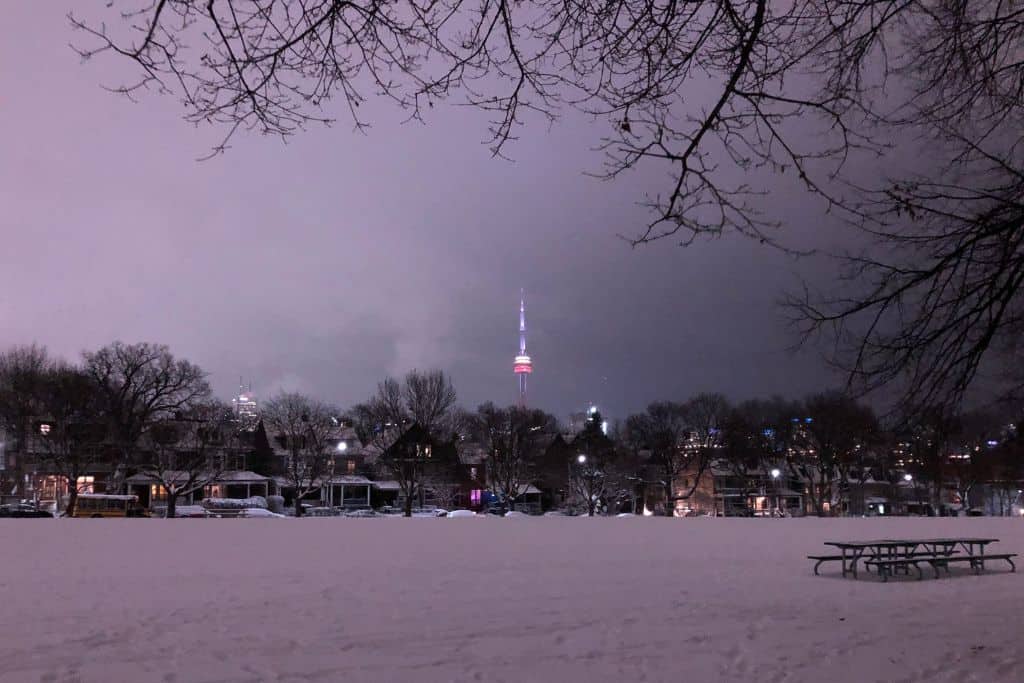
Gun Violence
Gun violence is a topic that often makes headlines in Toronto, but it’s important to put it into perspective. While the city has seen an increase in gun-related incidents in recent years, the risk to tourists and everyday residents remains very low.
Most incidents are targeted and involve individuals connected to gangs or criminal activity, rather than random acts of violence.
Gun violence in Toronto tends to be concentrated in specific neighbourhoods, such as Jane and Finch, Regent Park, and certain parts of Scarborough, which aren’t typically tourist destinations.
The City of Toronto and local law enforcement have implemented several measures to address gun violence, including increased police presence in high-risk areas and community programs aimed at youth outreach. Encouragingly, gun violence in Toronto has shown signs of decreasing in recent years, thanks to these efforts.
Additionally, Canada’s strict gun control laws—which require background checks, licensing, and restrictions on certain types of firearms—help limit the availability of guns compared to countries like the United States.
As a visitor, your risk of being affected by gun violence is extremely low. However, it’s always a good idea to stay aware of your surroundings and avoid high-risk areas, especially at night. Stick to well-lit, busy streets and follow local news for updates on any ongoing issues.
Petty Crimes
Petty theft, such as shoplifting, bicycle theft, and stealing from an employer, are among the most common crimes in Toronto.
Petty Theft & Pick Pockets
For visitors and newcomers to Toronto, petty theft is the most relevant concern. This includes:
- Opportunistic Theft: Leaving valuables unattended in cafes, parks, or vehicles can make you a target.
- Bicycle Theft: Bike theft is a growing issue in Toronto. Always use a sturdy lock and park in well-lit, busy areas. However, even these precautions aren’t always enough to deter thieves, so try not to leave your bike unattended for long periods.
- Pickpocketing: While pickpocketing and muggings are rare, they can occur in crowded tourist areas like Yonge-Dundas Square or on public transit.
Fortunately, petty crimes are often preventable with a little awareness. Keep your belongings secure, avoid leaving valuable items unattended, and stay alert in busy areas.
Scams in Toronto
Scams are another concern for visitors and residents, though they’re usually easy to avoid with some caution. Here are the most common scams to watch out for in Toronto:
Internet Scams
- Fake Accommodation Rentals: Scammers post fake listings on platforms like Airbnb or Kijiji, often requesting payment upfront. Always book through trusted websites, read reviews, and verify the legitimacy of the listing.
- Ticket Scams: Fake tickets for concerts, sports events, or attractions are common. Stick to official vendors or reputable resale platforms, read reviews, and check the page is secure before entering your credit card information.
Most importantly, if you have a bad feeling about something, trust your instinct!

The Taxi Scam
Another scam i’ve come across in Toronto recently is the taxi scam. And I even know someone who fell victim to this recently!
- How It Works: When taking a taxi and paying by card, the driver uses a fake card reader to steal your PIN and then swaps your real card for a fake one. This scam often targets tired or intoxicated passengers late at night who are less likely to notice the card returned to them isn’t theirs.
- How to Avoid It: Use ride-sharing apps like Uber or Lyft, where payments are handled securely through the app. If you do take a taxi, double-check the card returned to you or pay in cash.
While scams like this can happen, it doesn’t mean taxis are unsafe overall. I’ve had some great experiences with taxis in Toronto, although I do generally prefer to stick to Uber and Lyft.
Public Transport & Getting Around
When visiting Toronto, you’ll want to visit all the incredible attractions and neighbourhoods the city has to offer. But you might be wondering: What’s the safest and best way to get around?
The good news is that Toronto is a compact and well-connected city, with downtown spanning just 16.6 square kilometres. Whether you prefer walking, driving, cycling, or taking public transit, there are plenty of safe and convenient options.
Having lived in Toronto since 2018, I’ve traveled around the city in just about every way possible, and I’ve never felt unsafe. That said, each mode of transportation comes with its own risks, and it’s worth knowing what to expect before navigating the city.
Is It Safe to Walk in Toronto?
Toronto is a very walkable city, and I’ve always found it safe to explore on foot. Most areas are pedestrian-friendly, with wide-enough sidewalks, crosswalks, and streetlights. However, there are a few hazards to be aware of:
Construction
Toronto always seems to be under construction! Sidewalks near construction sites can be narrow, closed, or obstructed by equipment. To avoid obstacles or walking in the road, cross to the other side of the street when you see construction ahead.
Slippery Sidewalks
Secondly, in the winter, the sidewalks can be slippery! The winters in Toronto are very cold, and there can be snow. As a result, ice builds up on the sidewalks. And although the city does a good job of clearing the snow and salting the footpaths, you still need to be cautious.
Winter in Toronto can be harsh, with snow and ice making sidewalks slippery. While the city and its residents do a good job of clearing snow and salting footpaths, it’s still important to tread carefully and wear sturdy winter boots when walking in icy conditions.
Traffic
As a big city, Toronto has a lot of traffic, including aggressive drivers and cyclists, who can make mistakes or fail to respect the road rules. As such, always look both ways before crossing the street—even at pedestrian crossings—and stand back from the road while waiting to cross.

Encounters with Unsavoury People
Unfortunately, Toronto has a sizeable homeless population, and you may encounter people acting erratically, using drugs, or intoxicated in some areas, especially late at night. In most cases, they’re harmless, and the best approach is to keep your distance and avoid engaging.
If you ever feel unsafe, head to a more crowded area or step into a store or café. Despite these occasional encounters, walking is actually my favourite way to explore Toronto! It’s a great way to discover hidden gems, experience different neighbourhoods, and stay active.
Personally, I’ve always felt safe walking alone, even at night. However, if you’re unfamiliar with the city, I recommend always walking with someone else, and sticking to well-lit, busy areas after dark where there are other people around.
➡️ BOOK: Guided Toronto Walking Tour
Is the TTC Safe?
Toronto’s public transit system, the Toronto Transit Commission (TTC), is one of the safest in the world. But, there has been a lot of sensational media reports recently, highlighting an increase in violent incidents. While these reports can be alarming, it’s important to put them into perspective.
TTC Safety by the Numbers
2022 was a particularly challenging year for the TTC, with crime rates 46% higher than in 2021 and significantly higher than pre-pandemic levels. This increase in violent incidents wasn’t unique to Toronto—it was part of a broader trend across major North American cities as public transit systems recovered from the pandemic.
Although, despite this spike, the crime rate was still very low when put into perspective. There were 575.65 million rides on the TTC, compared to 1,068 violent incidents reported. That’s fewer than 1 incident per 500,000 rides!
The good news is that crime issues on the TTC have declined in 2023 and 2024. According to preliminary reports:
- In 2023, violent incidents on the TTC dropped by approximately 15% compared to 2022, despite ridership increasing to an estimated 600 million rides.
- In 2024, the downward trend has continued, with early data suggesting another 10% reduction in violent incidents compared to 2023.
These improvements can be attributed to several factors, including:
- Increased Security Measures: The TTC has deployed more security personnel, installed additional surveillance cameras, and introduced emergency alarms on buses and trains.
- Community Outreach: Enhanced support for vulnerable populations, including mental health and addiction services, has helped address some of the root causes of disruptive behavior.
- Public Awareness: Riders are more vigilant and proactive in reporting incidents, which helps deter crime.

My Experience Using the TTC
Living in downtown Toronto, I have the luxury of the TTC right on my doorstep. While I usually prefer to walk or bike around the city, there are times when taking the subway, streetcar, or bus is the most practical option.
In my 7+ years living in Toronto, I’ve never felt unsafe or uneasy on any of the city’s public transit. And while many locals love to complain about the TTC, I’ve always found it to be a convenient and efficient way to get around.
The worst thing you can usually expect on the subway or streetcar is service delays, which can occur due to weather, incidents on the track, or backed-up traffic. But in my experience, these delays aren’t any more frequent or severe than in other urban hubs. In fact, I find the TTC to be less crowded and more comfortable compared to public transit in other major cities, especially London and New York!
How to Stay Safe on the TTC
While the TTC has faced challenges in recent years, it remains one of the safest and most reliable public transit systems in North America. That said, there are still some precautions you can take to ensure a smooth and safe ride:
- Avoid traveling alone late at night.
- Always pay attention to your surroundings.
- Don’t leave your belongings unattended.
- If something makes you feel uneasy, don’t hesitate to move away, get off at the next stop, sit with other people, or notify a member of staff.
Is It Safe to Drive in Toronto?
Driving in Toronto is generally safe, but it can be a little daunting, especially if you’re not used to big-city traffic.
Personally, I don’t like driving in Toronto as I find it a bit chaotic, and other drivers can sometimes be quite aggressive. That said, I’ve never actually had any problems driving here, and it’s not as bad as some of the other cities I’ve driven in!
Unless you’re traveling somewhere outside the city, driving isn’t the most practical way to get around Toronto. I’d recommend avoiding it as much as possible, particularly in winter, when icy roads and reduced visibility make it the most dangerous time to drive.
Road Conditions
Toronto has good infrastructure, with clear signage and traffic lights, but the roads are infamous for their potholes! Frequent construction can also cause lane closures and detours, adding to the challenges of navigating the city by car.
Traffic and Drivers
As a major city, Toronto has a lot of traffic, which leads to congestion and stressful driving conditions. As a result, drivers here tend to be impatient and quick to frustration, so it’s not uncommon to encounter aggressive driving or even road rage.
Parking
Parking in Toronto can be tricky. It’s often expensive and hard to find, especially in busy downtown areas. And parking enforcement officers are relatively ruthless—if you park illegally, expect to get a ticket!
Driving Tips
If you’re planning to drive in Toronto, here are a few things to keep in mind:
- One-Way Streets: Toronto has many one-way streets, so pay close attention to signage.
- Right on Red: You can turn right on a red light in Toronto (and most of Canada), but always check for pedestrians and oncoming traffic first.
- Winter Driving: If you’re not experienced with winter driving, consider using public transit or ride shares during snowy or icy conditions.
While driving in Toronto can be stressful, it’s manageable with a little preparation and patience.

Taxis and ride shares (such as Uber and Lyft) are both safe in Toronto. However, as I mentioned earlier, there have been some recent issues with taxi scams.
These days, ride shares tend to be the safer option. Payments are handled through the app, and the ride is tracked, which helps protect you from scams. Plus, if you’re not familiar with Toronto, it’s easier to type your address into an app than to explain it to a taxi driver. Ride shares are also generally cheaper than taxis in Toronto!
Most of the time, ride shares are easy to order, and the wait is only a few minutes. However, during busy periods, it can sometimes be quicker to flag down a taxi on the street. (Look out for the green and orange cars.)
Personally, I’ve never had a bad experience with a taxi in Toronto. But as a personal preference, I feel more comfortable using ride shares. I always try ordering an Uber first before considering a taxi.
Is It Safe to Cycle in Toronto?
Cycling is one of my favorite ways to get around Toronto, and in the warmer months, you’ll always find me out on my bike. The city is actually very cycling-friendly, with an extensive network of bike paths, a bike share program, and ongoing improvements to its cycling infrastructure.
The City of Toronto also provides an interactive cycling map, which shows all the bike paths, suggested routes, and bike share locations around the city.
While it’s generally safe to cycle in Toronto, there are a few things you should keep in mind:
Cycling Hazards
The biggest hazard for cyclists in Toronto is traffic, as some bike routes are on the street. It’s important to know the road rules and understand how to signal properly while cycling. If you prefer to avoid roads altogether, you can use the cycling map to find off-street bike paths.
Road Conditions and Weather
Like walking or driving, cycling in Toronto comes with its own set of challenges. Road conditions, weather, and construction can all pose risks. In particular, it’s best to avoid cycling when there’s ice and snow, as it becomes much more difficult and dangerous.
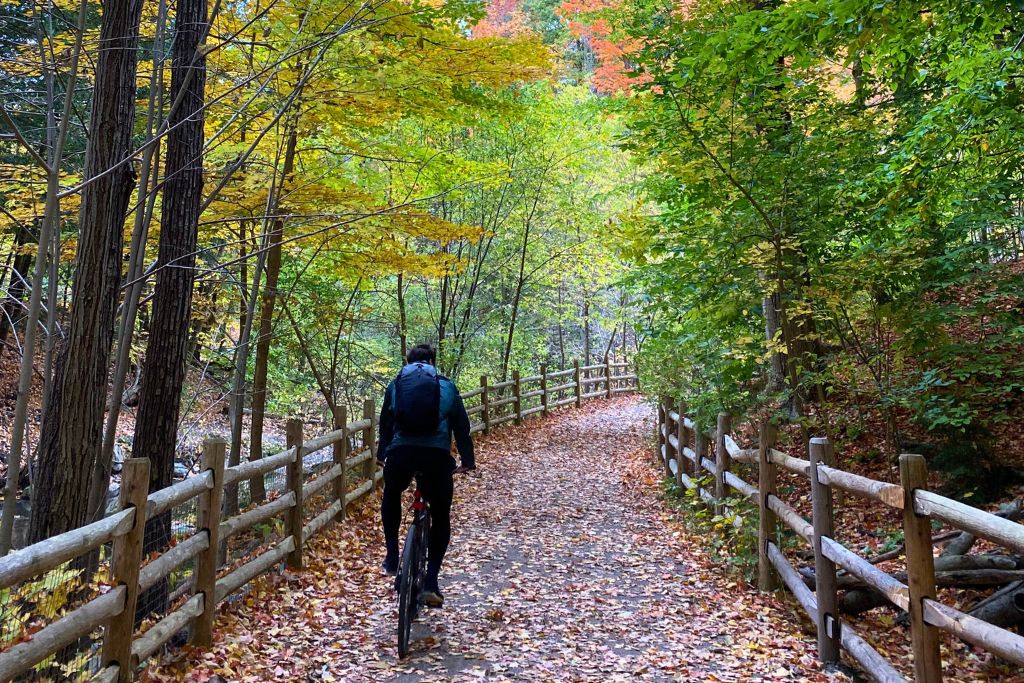
Cycling Safety Tips
- Helmets: While not legally required in Toronto, wearing a helmet is highly recommended, especially when cycling on busy roads.
- Visibility: If you’re cycling at night, make sure your bike has lights and that you’re visible to drivers and pedestrians.
Cycling in Toronto is a great way to explore the city, but staying safe means being prepared and aware of your surroundings.
Weather & Air Quality in Toronto
Depending on when you visit Toronto, your biggest safety concern might actually be the weather. From icy winters to humid summers, the city experiences a wide range of weather, and at times some extreme conditions. Here’s what you need to know to stay safe and comfortable.
Cold and Harsh Winters
Toronto’s winters can be extremely cold, with plenty of ice, strong winds, and sometimes even heavy snow. These conditions can make getting around the city more difficult.
Driving conditions become more dangerous with ice and poor visibility. Getting around on foot can also be hard due to slippery sidewalks and the severe cold making it unsafe to be outside for too long.
Luckily, the city is well-prepared for harsh winter weather and is usually quick to clear snow and salt footpaths. However, this year has been a bit of an exception due to much heavier-than-usual snowfall.
After a couple of major snowstorms in February, it took the city a full week to clear the roads and sidewalks downtown. This slowed down cars, streetcars, and foot traffic and made cycling nearly impossible. On the bright side, the city looked especially beautiful blanketed in snow!
If you’d rather avoid the cold altogether, there are ways to get around Toronto without going outside. You can use the subway or explore The PATH, Toronto’s 30-kilometre-long network of underground walkways.
The PATH connects major tourist attractions and office buildings in downtown Toronto, providing a warm and safe way to get around during the winter months. While navigating The PATH can be tricky at first, it’s a lifesaver when the weather turns harsh.
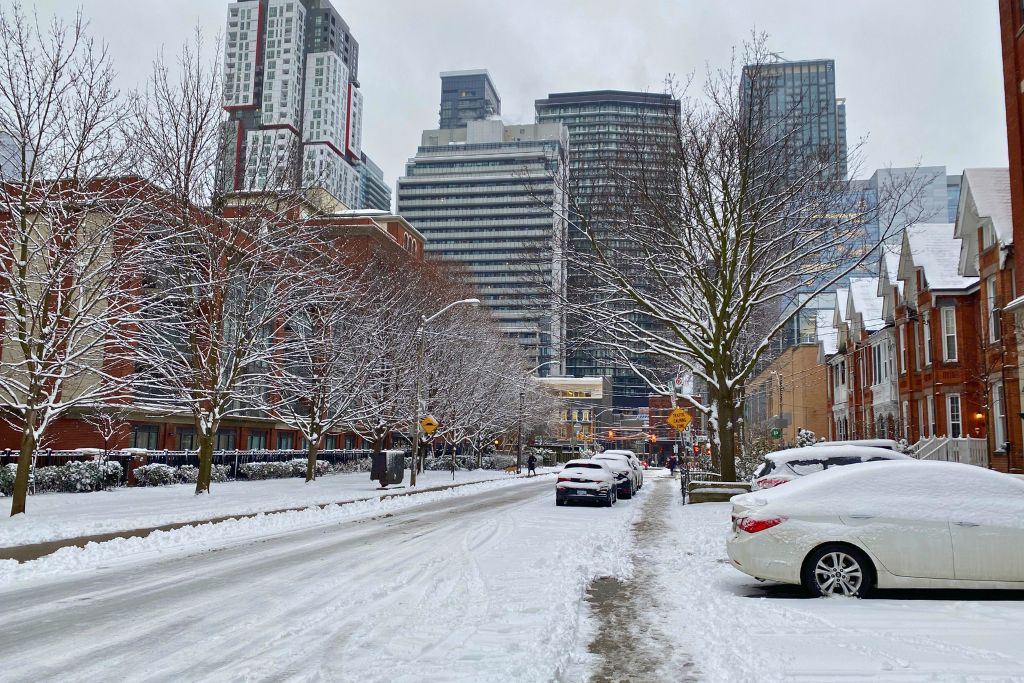
Hot and Humid Summers
In contrast to its icy winters, Toronto enjoys beautiful hot and sunny summers. And while this is usually considered the best time of year to explore, the city can experience extreme heat and humidity, which can pose health risks.
When temperatures soar, the city issues heat warnings and implements a heat relief strategy to assist those who are most vulnerable to heat-related illnesses.
The best way to stay safe during hot weather is to stay hydrated, wear sunscreen and protective clothing, and seek shade or air-conditioned spaces during the hottest part of the day.
Occasional Issues with Air Quality
Toronto’s air quality is generally good for a major city, but like any urban area, it faces challenges from traffic emissions, industrial activity, and commercial buildings.
In recent years, Toronto has also experienced air quality issues due to wildfire smoke, particularly during the spring and summer months. While these events are rare, they can be dangerous, especially for those with respiratory conditions.
During periods of poor air quality, the City of Toronto issues health warnings, and you can monitor the Air Quality Health Index (AQHI) for updates.
If you are in Toronto during a smoke event, it’s best to stay indoors as much as possible, avoid exercising outdoors, and use air purifiers if available.
Water Safety in Toronto
Drinking Water
You’ll be pleased to know that Toronto’s tap water is perfectly safe to drink!
The city’s water supply undergoes rigorous testing and treatment to ensure it meets all safety standards. The water actually comes from Lake Ontario and is then filtered, treated with chemicals and tested to meet the City of Toronto’s strict water quality standards.
Swimming in Lake Ontario
In addition to providing the city’s drinking water, Lake Ontario is one of Toronto’s key attractions. You might be surprised to learn that Toronto has quite a few beaches, many of which are excellent places to swim in the summer.
You can also do a range of other water sports on Lake Ontario, such as paddle boarding, canoeing and kayaking.

However, the water quality in Lake Ontario can vary depending on the weather. After heavy rainfall, bacteria levels in the lake can increase, so it’s best to avoid contact with the water for 48 hours.
Lake Ontario is also one of the largest lakes in the world, so swimming here comes with the same risks as any large body of water, such as rip currents and occasional waves. To stay safe, always swim at monitored beaches and follow swim safety practices.
Food Safety in Toronto
Toronto has one of the best and most diverse food scenes in the world. Thanks to its multicultural population, the city is a foodie’s paradise, offering everything from authentic international cuisine to fine dining, unique street food, and fresh produce. And luckily, the food is also very safe!
Restaurants
Food establishments in Toronto are subject to strict health regulations and undergo regular inspections by public health officials. The city enforces specific guidelines to ensure that food handling and preparation meet the highest safety standards. Restaurants are required to display their food safety certificates onsite, and if you have concerns, you can check their health inspection history online here.
Street Food
Street food is generally safe to eat in Toronto, but it’s always a good idea to exercise caution. Stick to reputable vendors and ensure the food is cooked thoroughly before eating.
Fresh Produce
The fresh produce sold in grocery stores and at markets in Toronto is also safe. However, as with anywhere, make sure to wash your fruits and vegetables, avoid eating raw meat or seafood, and check the “best before” dates on packaging.
Wildlife in Toronto
Canada is known for its dangerous wildlife, such as bears, moose, and wolves. But rest assured, you won’t encounter any of these animals in Toronto—they’re not big-city dwellers!
That said, Toronto is home to a surprisingly diverse range of wildlife. You’ll find plenty of squirrels, rabbits, raccoons, skunks, and Canadian geese, as well as over 300 species of birds. In larger parklands and residential areas, you might even spot foxes, coyotes, opossums, deer, and snakes.
While most of the animals you’ll encounter are harmless, they’re still wild animals that can scratch or bite and may carry diseases like rabies. To stay safe, always keep a respectful distance and avoid disturbing their habitats.

Coyotes in Toronto
It’s worth noting that in the past couple of years, coyotes have become more active in downtown Toronto. While they’re primarily focused on scavenging for food and aren’t typically interested in people, it’s best to stay away from them and exercise extra caution. This is especially important if you have a dog—always keep them on a leash and pick up small dogs if you spot a coyote.
I’ve already walked past two coyotes this year in Toronto, although there have probably been more that I didn’t notice!
Safest and Most Dangerous Areas
Toronto is generally safe, but like any major city, some neighbourhoods are safer than others. When planning your visit, it’s helpful to know which areas are the safest and which ones are best to avoid.
Safest Neighbourhoods in Toronto
Fortunately, downtown Toronto and many of the surrounding neighborhoods have low crime rates and are considered very safe. In particular, the key attractions you’ll want to visit are located in some of the city’s safest areas. These include:
- Financial District: The heart of Toronto’s business world, this area is bustling during the day and quiet at night, with a low crime rate.
- Harbourfront-CityPlace: A popular tourist spot with stunning lake views, parks, and cultural attractions. This is where the CN Tower, Ripley’s Aquarium, and the Rogers Centre are located.
- Distillery District: Known for its historic charm, cobblestone streets, and art galleries, this area is both safe and picturesque.
- Bloor-Yorkville: An upscale area with luxury shops, fine dining, and a relaxed, safe atmosphere. This is also where you’ll find the Royal Ontario Museum (ROM).
- Casa Loma: A wealthy neighbourhood, home to the historic Casa Loma castle, that’s popular with tourists and locals alike.
In and around Toronto’s downtown, you’ll also find some beautiful, safe, and walkable residential neighbourhoods worth exploring:
- The Annex: A vibrant neighborhood with tree-lined streets, historic homes, and a mix of students and professionals.
- Trinity Bellwoods: A trendy area with one of Toronto’s best parks, hip cafes, and a lively arts scene.
- Palmerston-Little Italy: Known for its Italian restaurants, cozy bars, and walkable streets.
- Roncesvalles: A charming neighbourhood with a strong Polish heritage, boutique shops, and a family-friendly vibe.
- High Park: Home to Toronto’s biggest park—High Park—which has gardens, hiking trails, and even a free zoo to explore.
- North Riverdale: A quiet, residential area with parks, local shops, and a strong sense of community.
- The Beaches: A laid-back neighbourhood with a boardwalk, sandy shores, and a small-town feel.
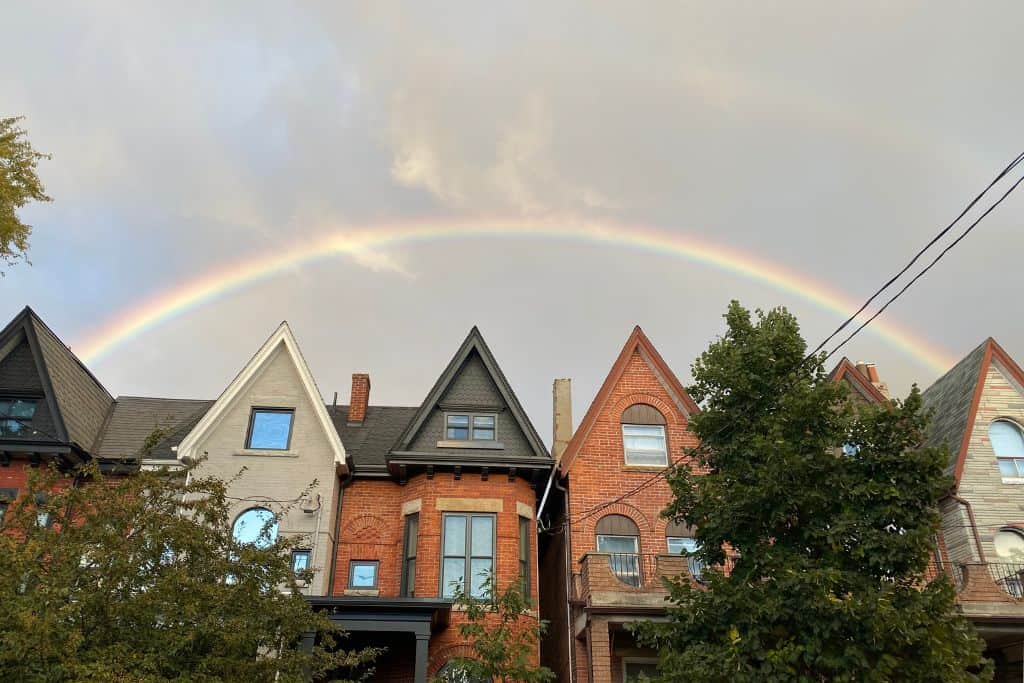
Neighbourhoods to Avoid
While I’ve never felt unsafe anywhere in Toronto, there are a few areas that are usually not recommended for visitors due to higher crime rates and larger homeless populations. These include:
- Church and Wellesley: While this area is the heart of Toronto’s LGBTQ+ community and generally safe during the day, it can feel less welcoming at night due to occasional issues with homelessness and petty crime.
- Upper Jarvis: This area has a higher concentration of social housing and can feel less safe, especially after dark.
- Bay Street Corridor: While mostly safe, this area has pockets of higher crime, particularly around Dundas Square and parts of Yonge Street.
As a general rule, I’d recommend avoiding the area from Sherbourne and Bloor down to Jarvis and Queen, and across to Dundas and Parliament. Although I’ve never had any issues passing through these neighbourhoods, they can feel less comfortable if you’re not familiar with the city. Plus, there aren’t many tourist attractions in these areas anyway.
Is It Safe to Visit Toronto Right Now?
Yes, Toronto is absolutely safe to visit right now! In fact, Toronto is a safe city to visit at any time of year. However, if you’re looking for the safest and most enjoyable time to visit, I’d recommend planning your trip between May and October.
Visiting during these months means you won’t have to contend with the ice, snow, and harsh cold of a Toronto winter. This makes it safer and easier to walk, drive, and bike around the city. Plus, it’s much more pleasant to explore when it’s not freezing cold!
The summers in Toronto are beautiful, with long days, warm weather, and plenty of outdoor events and festivals. Fall is also an excellent time to visit, as the temperatures remain mild and the city lights up with vibrant autumn foliage.
Visiting Toronto in 2025
In 2025, Toronto continues to be a welcoming and secure destination for all travellers. The city has maintained its reputation as one of the safest major cities in North America, with low crime rates and a strong focus on public safety. Whether you’re visiting downtown attractions, enjoying the waterfront, or exploring charming neighbourhoods, you can feel confident and at ease during your visit.
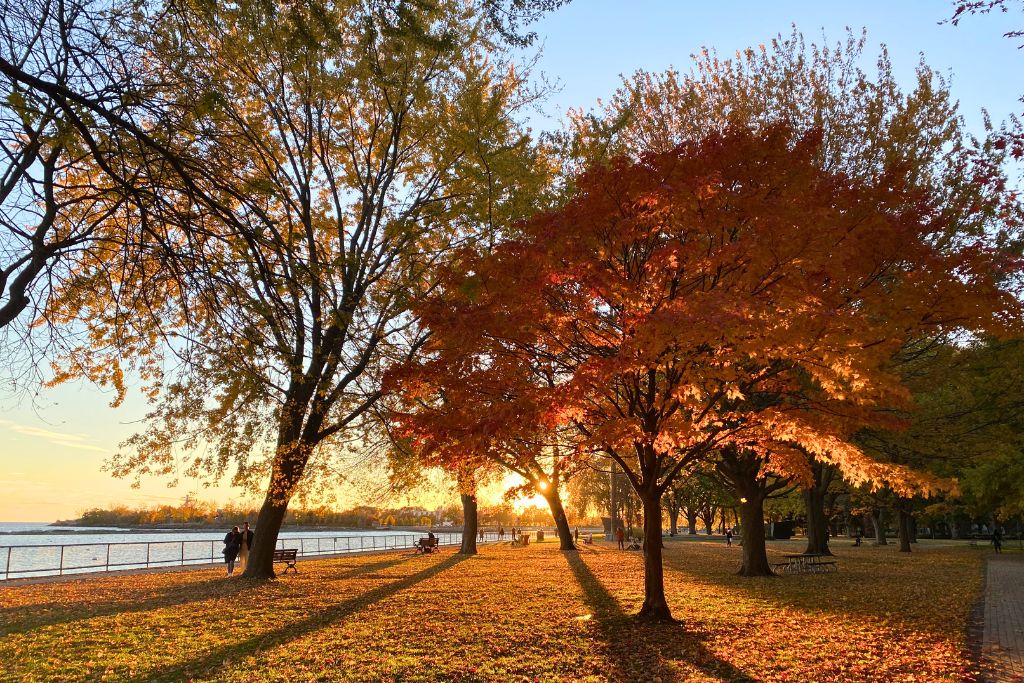
Is It Safe to Live in Toronto?
Toronto is a very safe city to live in—and I know this firsthand, as I’ve lived here since 2018! In fact, out of all the cities I’ve lived in around the world (including London and Sydney), Toronto feels the safest. It’s consistently ranked as one of the safest major cities in North America, with low crime rates and a strong sense of community.
While there are some crimes that locals are more at risk of than visitors—such as breaking and entering, theft, and certain scams—the same general safety considerations apply to both residents and tourists.
When you first move to Toronto, the city can feel a little daunting. In my first few weeks living here, I was definitely a little overwhelmed at times before I got into the swing of things. But over time, you’ll become more familiar with the neighbourhoods and feel completely at ease with the risks of big-city living. Plus, you’ll learn to appreciate Toronto for all its quirks and interesting characters!
Safety Tips for Visiting Toronto
To help you stay safe in the city, here are my top safety tips to keep in mind when visiting Toronto.
1. Ensure You’re Covered by Travel Insurance
Ontario has an excellent healthcare system, but if you don’t live in Canada, you may not be covered. Always take out a travel insurance policy before traveling to Toronto. This is also important in case you encounter other unforeseen issues, such as lost luggage or theft. I recommend using SafetyWing, as they offer affordable and comprehensive policies.
2. Know How to Contact Emergency Services
Make sure you know the emergency numbers in Toronto! The general emergency number is 911, and you can reach the Toronto Police Service at 416-808-2222 for non-emergencies.
3. Be Aware of Your Surroundings
Like in any big city, it’s important to always be aware of your surroundings. Be mindful of who is around you and keep an eye on your belongings, especially in crowded areas.
While pickpocketing isn’t common in Toronto, don’t put yourself in a position where it can occur. Always keep your bags zipped, and be cautious when using ATMs.

4. Use Reputable Transportation
When using taxis or rideshare services, stick to reputable companies. Uber and Lyft are widely used and considered the safest options in Toronto. If you choose to use a taxi, make sure it’s an official one, and be cautious when paying to avoid scams.
Toronto’s public transportation system—including subways, buses, and streetcars—is excellent and generally safe. However, be cautious during late-night hours, avoid empty subway cars, and don’t hesitate to move if you ever feel uncomfortable.
5. Be Extra Cautious at Night
Although Toronto is a safe city at night, it’s important to be extra cautious if you’re walking around after dark, especially if you’re alone.
Stick to well-lit areas and busy streets, and always know where you’re going. Avoid taking shortcuts through alleys or quiet, isolated areas, and save exploring unfamiliar places for the daytime.
6. Be Prepared for the Weather
Toronto experiences all four seasons and can have harsh weather. Always be prepared for extreme conditions, such as snow in winter and high temperatures in summer. Check the weather forecasts in advance so you can pack accordingly.
Fortunately, Toronto is not prone to natural disasters, but it’s a good idea to know the emergency procedures just in case of unexpected events.
7. Navigate Traffic Safely
When crossing streets, use pedestrian crosswalks and obey traffic signals. Toronto has a lot of traffic, and drivers can be aggressive, so always double-check before crossing.
If you’ll be driving in Toronto, familiarize yourself with the road rules ahead of time. And remember to stay calm—driving in the city can be stressful!
8. Keep Travel Documents Safe
Always keep copies of important travel documents, such as your passport, ID, and travel insurance, in a separate place from the originals in case they get lost or stolen.

9. Ask Locals for Advice
If you have any concerns about safety or need local advice, don’t hesitate to ask! Canadians are very friendly and willing to help. Toronto is the type of place where you can ask passersby for directions or assistance. Plus, the staff at your hotel should be able to provide you with lots of information and advice.
10. Trust Your Instincts
While most areas in Toronto are safe and your chances of encountering a dangerous situation are quite low, you never know what can happen. Always trust your instincts.
If something doesn’t seem right, you feel uncomfortable, or you have any safety concerns at all, don’t hesitate to act on your instincts and remove yourself from the situation.
FAQs
Is It Safe to Walk at Night in Toronto?
Toronto is generally a safe place to walk around at night. However, some areas are more safe than others, so make sure you do your research on the neighbourhood you’ll be in. You should also always stick to well-lit areas and busy streets and avoid exploring unfamiliar places or isolated areas after dark.
Is It Safe for Solo Travellers in Toronto?
Yes, Toronto is a very safe city to travel to alone. The city is walkable and easy to navigate, people are friendly, and it’s easy to meet like-minded travellers. Plus, if you want to see the sites with other people, there are plenty of tours available. And, most hostels in Toronto also offer female-only dorms, making it a great destination for solo female travellers.
That said, it’s always important to do some research in advance (like reading this blog post!) and take basic safety precautions while traveling alone.
Is Toronto Safe for Families?
Yes, Toronto is a safe city for families to visit. The same safety risks mentioned above apply to solo travelers, couples, and families alike.
Is Toronto Safe for Women?
Yes, Toronto is very safe for women. The city is walkable, public transportation is reliable, and locals are generally friendly and helpful. However, as with any destination, it’s important to stay aware of your surroundings, especially at night, and avoid isolated areas.
What Is the Safest City in Canada?
According to the 2023 Canadian Crime Severity Index (CSI), the safest city in Canada is Québec City, Quebec. It’s followed by Barrie, Ontario, in second place, and Sherbrooke, Quebec, in third place. Toronto remains one of the safest major cities in Canada, consistently ranking well below the national average for crime severity.
Is Toronto or Montreal Safer?
According to the Canadian Crime Severity Index, Toronto is safer than Montreal.
Is Toronto or Vancouver Safer?
Toronto is also safer than Vancouver, according to the Canadian Crime Severity Index.

Is It Safe to Take the Subway at Night in Toronto?
It is generally safe to take the subway at night in Toronto. However, I’d recommend doing so only if you’re traveling with someone else. While the number of violent incidents on Toronto’s public transit system is low, it has increased in recent years, and the subway can feel intimidating at night when you’re alone.
Is Toronto Safe for Students?
Toronto is a popular destination for international students and is considered very safe. The city has a low crime rate, and universities often provide safety resources, such as campus security and shuttle services.
Is Toronto Safe for Tourists Who Don’t Speak English?
Yes, Toronto is a multicultural city where over 180 languages are spoken. While English is the primary language, you’ll find that many people are bilingual or multilingual. Most signs and public information are available in English, and locals are generally patient and willing to help.
Is Toronto LGBTQ+ Friendly?
Yes, Toronto is a very LGBTQ+ friendly city. It has a long-standing reputation for being inclusive and supportive of diversity and the LGBTQ+ community. This inclusivity extends to the tourism sector, with many hotels, restaurants, and businesses actively welcoming LGBTQ+ travelers.
The city is also known for hosting one of the largest Pride festivals in the world. June is Pride Month in Toronto, making it a great time to visit!
Is It Safe to Stay in an Airbnb in Toronto?
Airbnbs and other vacation rentals are just as safe in Toronto as they are anywhere else in the world. However, make sure to book your vacation rental through trusted platforms like Airbnb or VRBO . Booking directly with an owner (e.g., responding to an ad on Craigslist) is much less safe and can sometimes lead to scams.
Is It Safe for Pets in Toronto?
Toronto is a pet-friendly city with many parks, trails, and pet-friendly accommodations. However, always keep your pet on a leash in public areas and be mindful of wildlife, such as coyotes, in larger parks.

Final Thoughts on Safety in Toronto
So, is Toronto safe? The answer is yes—Toronto is a safe place to live in and travel to for all types of travellers.
While crime has seen an increase in recent years, the city still has a relatively low crime rate compared to other major cities. There are no significant natural disasters or other major risks to worry about, and with a little preparation, you can easily navigate the city safely.
Whether you’re exploring downtown attractions, enjoying the waterfront, or venturing into charming neighbourhoods, Toronto offers a welcoming and secure environment for everyone.
READ MORE
5 Best Toronto Helicopter Tours & Flight Experiences
10 Best Niagara Falls Tours From Toronto
When is The Best Time to Visit Canada?
35 Fun Facts About Canada That May Surprise You
